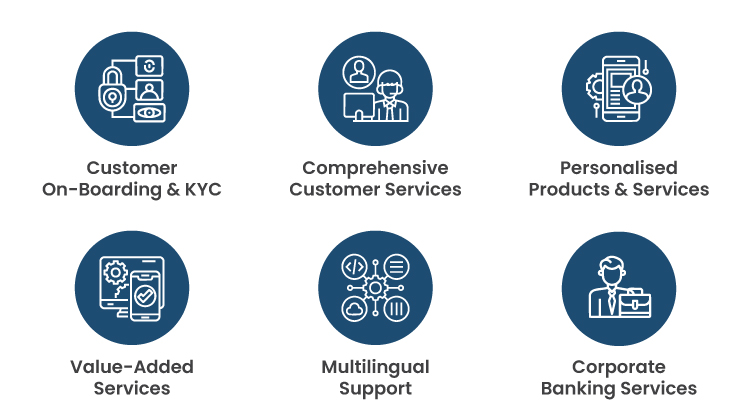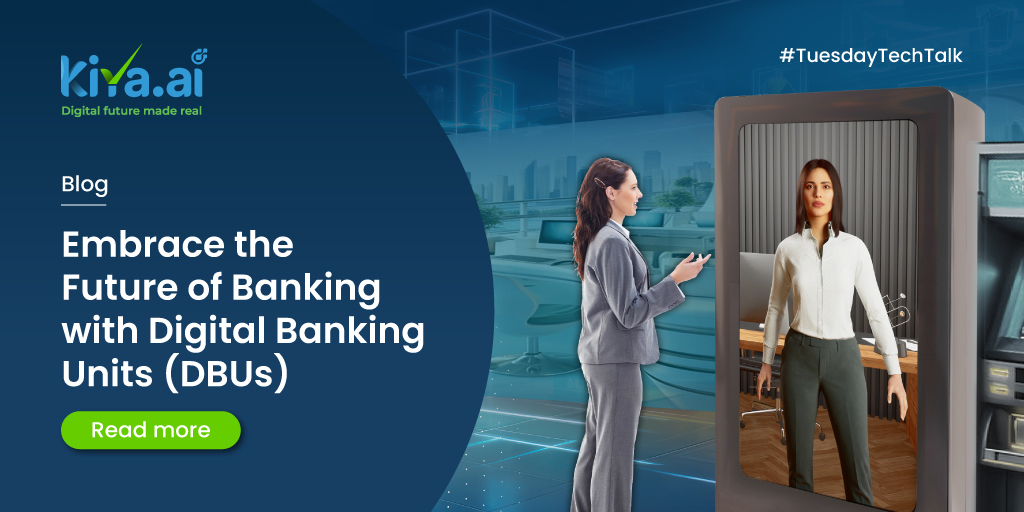Digital Banking Units: A Catalyst for Innovation in Financial Services

In an era where digital transformation is reshaping industries, Digital Banking Units (DBUs) are at the forefront of this revolution. A DBU acts as a specialised mini-branch, designed to deliver banking services with minimal physical infrastructure but maximum digital efficiency. Equipped with advanced technologies, such as AI-based humanoids and interactive kiosks, DBUs facilitate a seamless banking experience, making essential services accessible to customers. This innovative approach not only streamlines banking operations but also enhances customer engagement and satisfaction.
Structure and Design of Digital Banking Units (DBUs)
Digital Banking Units (DBUs) represent a pioneering approach in the integration of technology with banking services. These specialised units are established with essential digital infrastructure to deliver comprehensive banking products and services. By focusing on both technology and customer interaction, DBUs aim to expand financial services and boost financial inclusion across diverse geographic locations. They are designed to operate effectively in tier 1 through tier 6 centres, without requiring prior approval, making advanced banking services more accessible.
DBUs distinguish themselves from traditional branches through their unique formats and digital-first designs. Banks can equip these units with a variety of advanced front-end technologies, including interactive teller machines, digital service terminals, and automated card issuance devices. While the core banking systems can be shared with existing infrastructure, they must be separated to ensure efficient and secure operations.
Operational Flexibility and Service Offerings of DBUs
Digital Banking Units offer banks significant flexibility in their operational models. Institutions can choose between managing DBUs with in-house teams or through outsourced service providers, provided they adhere to regulatory standards for outsourcing. Each DBU is overseen by a senior executive, typically a Chief Operating Officer, who ensures that digital banking initiatives are effectively executed.
The services offered by DBUs are designed to meet a wide range of customer needs. They include account opening, digital loan applications, and cash transactions, which are conducted exclusively through automated machines such as ATMs and cash deposit devices. This streamlined approach enhances operational efficiency and aligns with the evolving demands of modern banking customers.
Key Features of Digital Banking Unit

- Customer On-Boarding & KYC:
DBUs simplify the account opening and KYC process through eKYC, CKYC, and VKYC. For instance, a customer can easily open a new account or update their KYC details using their smartphone, without visiting a physical branch.
- Comprehensive Customer Services :
From fund transfers to cheque processing, DBUs offer a wide range of banking services. For example, a user can request a new chequebook or print their passbook directly at a DBU, streamlining previously complex tasks.
- Personalised Products and Services:
By leveraging analytical data, DBUs can offer tailored financial products. For instance, if a customer frequently enquires about home loans, the DBU can proactively present personalised loan options and initiate the application process.
- Value-Added Services :
DBUs provide a variety of additional services, such as mobile recharges, tax payments, and insurance premium processing. Imagine a customer paying their utility bills and booking railway tickets in one go, all through a single digital interface.
- Multilingual Support:
To cater to a global audience, DBUs offer multilingual support, enhancing user experience. This feature ensures that users from different linguistic backgrounds can interact with the technology comfortably and effectively.
- Corporate Banking Services :
DBUs support corporate clients with services like document uploads and BG & LC requests. For example, a business can upload import/export bills and manage credit lines directly through the DBU, streamlining their financial operations.
The Impact of DBUs

Promoting Financial Inclusion & Digital Literacy
DBUs expand access to banking services in a paperless, efficient, and secure manner, especially for those without advanced tech infrastructure. This helps bridge the digital divide and promotes financial literacy.

Enhanced Customer Experience & Security
By offering contactless banking and AI-driven personalised services, DBUs improve the customer experience and reduce the risk of fraud. For example, real-time assistance through AI avatars ensures that customers’ issues are promptly addressed.

Low Operational Costs
DBUs provide a cost-effective solution with minimal infrastructure, reducing the need for physical branches and lowering operational expenses. Banks benefit from this streamlined approach, which also enhances service delivery.

Wider Geographical Reach
DBUs enable banks to serve a broader market, including non-tech-savvy consumers in smaller towns and villages. This increased reach helps build stronger customer relationships and expands the bank’s footprint.
Reduced Physical Footprint & Increased Profits
By minimising the need for physical branches, DBUs contribute to a reduced physical footprint and increased profitability. Banks can operate more efficiently, focusing resources on digital innovation.
As the digital banking landscape evolves, DBUs represent a necessary step towards a more inclusive, efficient, and customer-centric future. With its advanced features and broad range of services, DBUs are set to redefine banking experiences globally. To learn more about how KiyaAI can help you implement cutting-edge digital banking solutions, explore our offerings and join the transformation today.
Learn more about how KiyaAI, as the trusted NPCI technology partner and solution enabler can enhance your organisation’s digital payment infrastructure with our secure, seamless, and scalable digital solutions that align with modern needs and regulatory standards.

In an era where digital transformation is reshaping industries, Digital Banking Units (DBUs) are at the forefront of this revolution. A DBU acts as a specialised mini-branch, designed to deliver banking services with minimal physical infrastructure but maximum digital efficiency. Equipped with advanced technologies, such as AI-based humanoids and interactive kiosks, DBUs facilitate a seamless banking experience, making essential services accessible to customers. This innovative approach not only streamlines banking operations but also enhances customer engagement and satisfaction.
Structure and Design of Digital Banking Units (DBUs)
Digital Banking Units (DBUs) represent a pioneering approach in the integration of technology with banking services. These specialised units are established with essential digital infrastructure to deliver comprehensive banking products and services. By focusing on both technology and customer interaction, DBUs aim to expand financial services and boost financial inclusion across diverse geographic locations. They are designed to operate effectively in tier 1 through tier 6 centres, without requiring prior approval, making advanced banking services more accessible.
DBUs distinguish themselves from traditional branches through their unique formats and digital-first designs. Banks can equip these units with a variety of advanced front-end technologies, including interactive teller machines, digital service terminals, and automated card issuance devices. While the core banking systems can be shared with existing infrastructure, they must be separated to ensure efficient and secure operations.
Operational Flexibility and Service Offerings of DBUs
Digital Banking Units offer banks significant flexibility in their operational models. Institutions can choose between managing DBUs with in-house teams or through outsourced service providers, provided they adhere to regulatory standards for outsourcing. Each DBU is overseen by a senior executive, typically a Chief Operating Officer, who ensures that digital banking initiatives are effectively executed.
The services offered by DBUs are designed to meet a wide range of customer needs. They include account opening, digital loan applications, and cash transactions, which are conducted exclusively through automated machines such as ATMs and cash deposit devices. This streamlined approach enhances operational efficiency and aligns with the evolving demands of modern banking customers.
Key Features of Digital Banking Unit

- Customer On-Boarding & KYC:
DBUs simplify the account opening and KYC process through eKYC, CKYC, and VKYC. For instance, a customer can easily open a new account or update their KYC details using their smartphone, without visiting a physical branch.
- Comprehensive Customer Services :
From fund transfers to cheque processing, DBUs offer a wide range of banking services. For example, a user can request a new chequebook or print their passbook directly at a DBU, streamlining previously complex tasks.
- Personalised Products and Services:
By leveraging analytical data, DBUs can offer tailored financial products. For instance, if a customer frequently enquires about home loans, the DBU can proactively present personalised loan options and initiate the application process.
- Value-Added Services :
DBUs provide a variety of additional services, such as mobile recharges, tax payments, and insurance premium processing. Imagine a customer paying their utility bills and booking railway tickets in one go, all through a single digital interface.
- Multilingual Support:
To cater to a global audience, DBUs offer multilingual support, enhancing user experience. This feature ensures that users from different linguistic backgrounds can interact with the technology comfortably and effectively.
- Corporate Banking Services :
DBUs support corporate clients with services like document uploads and BG & LC requests. For example, a business can upload import/export bills and manage credit lines directly through the DBU, streamlining their financial operations.
The Impact of DBUs

Promoting Financial Inclusion & Digital Literacy
DBUs expand access to banking services in a paperless, efficient, and secure manner, especially for those without advanced tech infrastructure. This helps bridge the digital divide and promotes financial literacy.

Enhanced Customer Experience & Security
By offering contactless banking and AI-driven personalised services, DBUs improve the customer experience and reduce the risk of fraud. For example, real-time assistance through AI avatars ensures that customers’ issues are promptly addressed.

Low Operational Costs
DBUs provide a cost-effective solution with minimal infrastructure, reducing the need for physical branches and lowering operational expenses. Banks benefit from this streamlined approach, which also enhances service delivery.

Wider Geographical Reach
DBUs enable banks to serve a broader market, including non-tech-savvy consumers in smaller towns and villages. This increased reach helps build stronger customer relationships and expands the bank’s footprint.
Reduced Physical Footprint & Increased Profits
By minimising the need for physical branches, DBUs contribute to a reduced physical footprint and increased profitability. Banks can operate more efficiently, focusing resources on digital innovation.
As the digital banking landscape evolves, DBUs represent a necessary step towards a more inclusive, efficient, and customer-centric future. With its advanced features and broad range of services, DBUs are set to redefine banking experiences globally. To learn more about how KiyaAI can help you implement cutting-edge digital banking solutions, explore our offerings and join the transformation today.
Learn more about how KiyaAI, as the trusted NPCI technology partner and solution enabler can enhance your organisation’s digital payment infrastructure with our secure, seamless, and scalable digital solutions that align with modern needs and regulatory standards.
